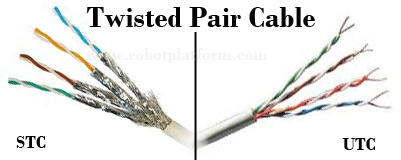Twisted Pair:

 Coaxial cable
Coaxial cable
 . BNC connector
. BNC connector
 . Fiber optic cable
. Fiber optic cable
-A type of cable that consists of two independently insulated wires twisted around one another.
-The use of two wires twisted together helps to reduce crosstalk and electromagnetic induction.
-While twisted-pair cable is used by older telephone networks and is the least expensive type of local-area network (LAN) cable, most networks contain some twisted-pair cabling at some point along the network.

It is of two types
1. Shielded Twisted Pair Cable
2. Unshielded Twisted Pair Cable
1. Shielded Twisted Pair Cable
-Shielded twisted-pair cable encases the signal-carrying wires in a conducting shield as a means of reducing the potential for electromagnetic interference.
-STP cables, for example, use a thick braided shield that makes a cable heavier, thicker and more difficult to install than its UTP counterpart.
2. Unshielded Twisted Pair
-UTP cable is lightweight, thin and flexible, as well as versatile, reliable and inexpensive, millions of nodes have been, and continue to be, wired with this cabling medium
Coaxial Cable:
-Coaxial cabling has a single copper conductor at its center.
-A plastic layer provides insulation between the center conductor and a braided metal shield . The metal shield helps to block any outside interference from fluorescent lights, motors, and other computers.
-The two types of coaxial cabling are thick coaxial and thin coaxial.
1.Thin coaxial cable is also referred to as thinnet. 10Base2 refers to the specifications for thin coaxial cable carrying Ethernet signals. The 2 refers to the approximate maximum segment length being 200 meters. In actual fact the maximum segment length is 185 meters. Thin coaxial cable has been popular in school networks, especially linear bus networks.
2.Thick coaxial cable is also referred to as thicknet. 10Base5 refers to the specifications for thick coaxial cable carrying Ethernet signals. The 5 refers to the maximum segment length being 500 meters. Thick coaxial cable has an extra protective plastic cover that helps keep moisture away from the center conductor. This makes thick coaxial a great choice when running longer lengths in a linear bus network.
 Coaxial cable
Coaxial cable
Advantages:
It is highly resistant to signal interference.
It can support greater cable lengths between network devices than twisted pair cable.
Disadventages:
Coaxial cabling is difficult to install.
Coaxial Cable Connectors
The most common type of connector used with coaxial cables is the Bayone-Neill-Concelman (BNC) connector . Different types of adapters are available for BNC connectors, including a T-connector, barrel connector, and terminator. Connectors on the cable are the weakest points in any network. To help avoid problems with your network, always use the BNC connectors that crimp, rather screw, onto the cable.
 . BNC connector
. BNC connectorFiber Optic Cable:
-Fiber optic cabling consists of a center glass core surrounded by several layers of protective materials .
- It transmits light rather than electronic signals eliminating the problem of electrical interference. This makes it ideal for certain environments that contain a large amount of electrical interference. It has also made it the standard for connecting networks between buildings, due to its immunity to the effects of moisture and lighting.
The center core of fiber cables is made from glass or plastic fibers . A plastic coating then cushions the fiber center, and kevlar fibers help to strengthen the cables and prevent breakage. The outer insulating jacket made of teflon or PVC.
 . Fiber optic cable
. Fiber optic cable
There are two common types of fiber cables -- single mode and multimode.
-Multimode cable has a larger diameter; however, both cables provide high bandwidth at high speeds.
-Single mode can provide more distance, but it is more expensive.
Advantages:
-Fiber optic cable has the ability to transmit signals over much longer distances than coaxial and twisted pair. -It also has the capability to carry information at vastly greater speeds. This capacity broadens communication possibilities to include services such as video conferencing and interactive services.
Disadvantages:
-The cost of fiber optic cabling is more.
- It is more difficult to install and modify. 10BaseF refers to the specifications for fiber optic cable carrying Ethernet signals.

No comments:
Post a Comment